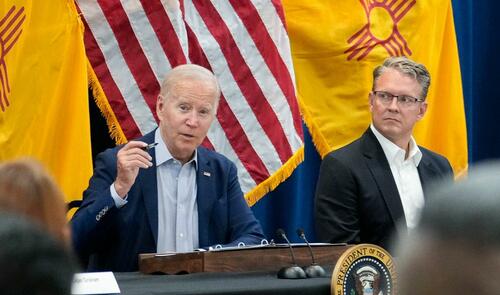By Rachel Premack of FreightWaves
Yellow, the third-largest trucking company in the less-than-truckload sector, filed for bankruptcy on Aug. 7. Now its former competitors are in a bidding war for its terminals and trucks.
The company’s collapse put some 30,000 employees out of work, including 22,000 Teamsters members. That’s an uncomfortable reality for those celebrating what appears to be a comeback for organized labor: the Teamsters’ ratification of a “lucrative” contract for its 340,000 members at UPS; the historic strike among Hollywood writers and actors; and hard-line leadership at the United Auto Workers who are seeking new labor agreements with a 40% pay increase. A 2022 Gallup survey found that U.S. approval of labor unions has hit its highest point since 1965.
For former Yellow employees, the much-ballyhooed comeback of unions, strikes and workers doesn’t quite apply.
It may be satisfying to place all of the blame on Yellow’s shutdown on Teamsters, whose leader appeared to only begin negotiating with the company when it was likely too late to reverse the exodus of customers.
However, trucking insiders and outsiders are increasingly pointing fingers at Yellow management or its hedge fund backers.
No party is unimpeachable for Yellow’s shuttering. And with only two unionized trucking giants left, it’s unclear how the revival of union organizing and hard-line labor leadership will affect America’s $800 billion trucking industry and its 2 million truck drivers.
“You have a highly financialized, debt-driven, short-term company that is then pushing for more concessions, setting up a paradigm in which we think, ‘OK, well, why couldn’t the Teamsters just save these 1,000 jobs to protect the other 22,000?’” Rana Foroohar, global business columnist and associate editor at the Financial Times, told FreightWaves. “From the Teamsters standpoint, in the current system, if you give an inch, they take a mile.”
Yellow said its restructuring program would save the company. Outsiders disagree.
Trucking experts told FreightWaves in recent interviews that Yellow did have a chance to survive. However, the company’s One Yellow plan, which aimed to merge its four disparate trucking networks, was probably not the answer to the long-suffering firm’s woes.
Yellow acquired several large competitors in the LTL space during the 2000s, miring the company in significant debt ahead of the Great Recession. At the end of 2007, according to its annual filing, Yellow had more than $822 million in long-term debt. That grew to nearly $1.5 billion by the end of 2022.
This massive liability had long prevented Yellow from investing in new equipment or technology, experts told FreightWaves. However, Yellow was adamant that the One Yellow restructuring would save the company.
“Early in 2023, when no one rationally believed IBT leadership would seek to destroy Yellow, killing 22,000 of its own members’ jobs in the process, Yellow’s future into 2024 and beyond was not in question,” a Yellow representative said in an emailed statement to FreightWaves.
One Yellow was supposed to cut costs and boost freight volumes for the trucking giant. Matthew Doheny, Yellow’s chief restructuring officer, said in an Aug. 7 document that Yellow anticipated that One Yellow “would grow EBITDA starting next year at $450 million to over $700 million within three years of implementation.” The plan did seem to please Yellow’s lenders; Doheny wrote that Yellow was beginning to refinance some of its lending requirements, which would have given more liquidity to the LTL carrier. A Yellow representative said the company had retained bankers to begin refinancing.
Some weren’t convinced by the strategy. Satish Jindel, president of transportation research firm SJ Consulting Group Inc., told FreightWaves that no other LTL carrier has the super-regional model Yellow proposed, making the untested model dubious.
“Ultimately, the company needed to be smaller,” J. Bruce Chan, a transportation analyst at the investment bank Stifel, told FreightWaves. “There are some differences of opinion over how that should have happened. The plan for Yellow, vis-à-vis their change of operations, was to integrate four networks with distinct operations and ultimately distinct cultures. That’s really where they went wrong because integrating cultures is very challenging. In that way, they destroyed a lot of value. What could have been done potentially is to shut down certain parts of the network or to sell off other parts of the network in order to fund the operations [remaining].”
A Yellow representative said One Yellow “already accounted for parts of the network that made more sense to divest than integrate.” She added that the plan would have addressed the debt that resulted from these acquisitions, which occurred under different management and a different board of directors.
“Arguments that prior acquisitions were a reason Yellow is now in bankruptcy has the entire situation backwards,” a Yellow representative said. “The IBT prevented Yellow from fixing these issues by refusing to negotiate — or to even meet to discuss — aspects of One Yellow on which IBT approval was necessary.”
Even if the integration plan was the best path for Yellow, the company did not solidify the necessary flexibilities in its 2019 labor agreement with Teamsters to make consolidating networks possible. A Yellow representative said these other changes could not be approved at that time because the plan was still in development.
“It was a bad bargaining decision to not create more flexibility with workers,” Aaron Peck — who is the CEO of Mothership, a freight booking platform that works with LTL companies — told FreightWaves.
Through its 2019 agreement, Yellow was able to complete consolidation in the Western U.S. in 2022. However, supplemental agreements in other parts of the country thwarted Yellow’s plans. A key sticking point for Teamsters was Yellow’s insistence that it would need to convert nearly 1,000 Yellow linehaul truck drivers into a “utility driver” role. Former Yellow employees previously told FreightWaves that the utility driver role would not only be a worse kind of job, but offer less pay, which a Yellow representative disputed.
“IBT leadership made mountains out of molehills: in total, 1,000 out of 6,000 line haul drivers would have been impacted,” a Yellow representative said. “Keep in mind that 400 Holland drivers were already performing ‘utility’ work, so the company was really only asking 600 additional drivers in the network to handle utility work. This is a practice widely used within the industry and drivers would have the chance to exercise their seniority to ‘bid’ on these jobs. As a result, the work would likely have gone to the most junior drivers who did not have seniority.”
Yellow previously offered the equivalent of an $11 hourly wage increase in pay and benefits if Teamsters accepted the company’s One Yellow plan. A Yellow representative said this was not their best and final offer and would have negotiated further, and said that they were not asking for concessions from Teamsters. Teamsters previously said they had already given $5 billion in concessions to Yellow since 2009.
‘Too little, too late’
Chan said Teamsters’ refusal to negotiate on a proposed change of operations was ultimately the “trigger point” for Yellow’s bankruptcy, but it wasn’t the fundamental reason. Yellow’s debt prevented the company from investing into technology or equipment. Partially as a result of that, Yellow struggled with pricing and service levels. The company’s revenue per shipment was typically much lower than its peers, including other unionized ones.
The Yellow representative said that the company would “still be in business today and for years to come” had Teamsters negotiated.
On July 18, following months of the Teamsters’ refusal to negotiate and the company’s previous request to defer payments, Yellow ultimately missed a required contribution to its pension and health care funds. Teamsters shortly after issued a notice of a strike as early as the following week.
Doheny of Yellow wrote in the Aug. 7 document that Yellow warned Teamsters that a strike notice would “irreparably harm” the company. And it did; on the Monday before the strike notice, Doheny wrote that Yellow hauled around 40,000 shipments. By Friday, Yellow counted “near zero” shipments.
Ten hours before the threatened strike, Doheny said Teamsters General President Sean O’Brien offered to secure a 30-day extension on Yellow’s health and pension obligations. That avoided a strike, but Doheny wrote this was “too little, too late.” The loss of customers sparked a sort of bank run on Yellow, Peck said. Yellow’s customers had mostly fled and the lack of incoming freight bills would push Yellow to the edge.
“The Union’s threat of a strike was the final straw that sealed Yellow’s fate,” Doheny wrote. “At bottom, after the catastrophic harm he had already deliberately caused Yellow, after his belligerence, after his months long refusal to engage Yellow’s management in a good faith effort to save the jobs of Yellow’s 30,000 employees, including its 22,000 Teamsters, Mr. O’Brien’s last second outreach amounted to little more than meaningless showmanship, and was an insult to all of Yellow’s employees who have now lost their jobs and to all who fought so hard for so long to save Yellow.”
Doheny’s sentiment was reflected in an Aug. 7 press release from Yellow that announced the company’s shutdown. The company said Teamsters forced Yellow into bankruptcy.
“Yellow considered all angles but in the end determined that business was lost and not recoverable,” a Yellow representative said in a statement to FreightWaves.
In an Aug. 7 statement, the Teamsters hit back at Yellow’s assertion that the union led to the downfall of the company.
“Teamster families sacrificed billions of dollars in wages, benefits, and retirement security to rescue Yellow,” O’Brien said in the Aug. 7 release. “The company blew through a $700 million government bailout. But Yellow’s dysfunctional, greedy C-suite failed to take responsibility for squandering all that cash. They still don’t.”
A Yellow representative said the $700 million loan, which was issued in 2020 as part of the CARES Act, could only be spent on pension, health and welfare payments for union employees and modernizing Yellow’s fleet of tractors and trailers. A June Congressional report concluded that this loan was a mistake in part due to Yellow’s “precarious financial position at the time of the loan.”
Teamsters ultimately sacrificed some 22,000 union jobs, and it was apparently because the union no longer trusted management
If Teamsters viewed Yellow management as consistently shoddy, that would be one reason why the union may have been OK with letting the company shutter.
“They lost confidence in the management,” Jindel told FreightWaves. “I would rather take a chance with other companies where I have some trust in what they’re doing.
“If I am in a car and I’m with you and you’re heading off a cliff, it doesn’t matter how much money you give me to ride in the car,” Jindel added. “I am going to get out of the car.”
A Yellow representative said Teamsters would have “no rational basis to believe that about management.”
“(T)he current Yellow management team, commencing with Darren Hawkins’ promotion to CEO in 2018, had been working on One Yellow for nearly 5 years and was fully ready to implement the final stage — the network optimization — when that was stopped by the IBT leadership,” a Yellow representative said.
Since the Great Recession, Yellow workers have struggled to receive similar pay and benefits as other unionized truck drivers. Most stinging to these employees may have been the underfunded pensions. Former Yellow employees previously told FreightWaves they had to scrap their retirement plans as a result. Some drivers estimated that they would earn $1,000 less per month in retirement.
“We have a lot of people who can’t retire now,” Pete Boese, a South Bend-based truck driver who previously worked at Yellow, told FreightWaves in July. “The pension is a pretty big deal.”
Labor experts speculated that Teamsters figured Yellow would never be in the financial position to ever deliver these benefits back to employees. The union likely wouldn’t want to have a massive chunk of its members with significantly worse pay or benefits — or for potential new union shops to see such disparities in Teamsters’ portfolio and to pass on organizing with them.
“You want UPS to be your model,” Steven Greenhouse, a former longtime labor reporter at The New York Times, told FreightWaves. “You wouldn’t want a very modest contract with Yellow to be your model.”
Greenhouse added that a rational union labor may agree to modest pay bumps to keep a company alive. However, Greenhouse said Teamsters likely believed that Yellow’s chances of survival were weak.
Other labor experts agreed with this assessment.
“The union and anybody in that position has to make a calculation whether or not you have confidence in management,” Marick Masters, a business professor at Wayne State University in Detroit, told FreightWaves. “Yellow had been granted loans to help it along, but nothing seemed to have worked.”
Such decisions may be prudent for a union that is looking to build its base and maintain high standards among its members. However, they’re less appealing when you’re on the other side of things — namely, any of the 30,000 people who used to work at Yellow.
“It’s the individual workers who are losing their jobs,” Cornell University’s Kate Bronfenbrenner, who is the institution’s director of labor education research, told FreightWaves. “Many of them might say half a paycheck is better than no paycheck.”
A Yellow representative said Teamsters “sacrificed” Yellow as a warning shot to other firms.
“Yellow would have been one of the greatest business turnaround success stories if IBT leadership did not maliciously stop it, harming their own members in the process,” a Yellow representative said. “Instead, the Teamsters chose to destroy Yellow to serve as a warning to other companies to get better future deals. Yellow and the 22K employees IBT leadership were supposed to represent were sacrificed.”
Unions are becoming bold in a way we haven’t seen in decades. It’s unclear how that will affect truck drivers.
It’s curious whether the shutdown of Yellow is an exception to the rule or if even more union trucking fleets will shut down as the leaders of labor organizations become more militant.
One reason why we probably won’t see many more shutdowns as massive as Yellow is, well, there aren’t many large unionized carriers left. ABF and TForce are the two largest, nationwide trucking companies with unionized workforces. They represent a collective 16,400 Teamsters members. Both companies saw Teamsters negotiations this year conclude without much hubbub.
“Yellow management and the financiers who pull the strings continue to blame union contracts for their demise,” O’Brien said in an Aug. 7 statement. “The fact is, Teamster-represented companies like ABF and TForce Freight are not only able to fairly compensate workers, they are also wildly profitable. The Teamsters successfully and continuously negotiates strong contracts to preserve the integrity of our members’ work and ensure they are justly compensated.”
d
A Yellow representative said the closure of the trucking giant has left many employees unlikely to find new union work.
“Had IBT leadership been willing to negotiate, employees would still have jobs, seniority, health care, and more money in their pockets,” the representative said. “Instead, they’re looking for new work in an industry where unionized company market share was just cut in half and the prospect of more than a handful of former Yellow employees securing new union jobs is unrealistic.”
As the number of union companies wears away, that leaves those still remaining at risk, Jindel said. Union companies have, by nature, less flexible workforces than their nonunion competitors. Even if those nonunion companies pay the same or more as their union counterparts, flexible work rules allows non-union fleets to reallocate workers where it suits them. That’s a key advantage for those firms, albeit one that union supporters say leads to worse quality of life for workers.
Some labor experts believe that Teamsters is scheming to unionize more trucking fleets. They believe it’s unlikely that Teamsters would have allowed Yellow to shutter if there wasn’t something else in the works to replace those members. As Chan pointed out, even amid the ongoing freight recession, employee truck drivers are still demanding — and winning — better conditions and pay.
But organizing labor unions in the United States, whether or not it’s in the trucking industry, is challenging. Even if the Teamsters union believes that it will be able to add a new trucking fleet to its membership, the laws of the U.S. are stacked against it.
“Corporations fight harder, more vigorously, more ferociously against unions and unionization efforts than companies in any other industrial nation — whether it’s Australia, New Zealand, Japan, Chile, France, Germany or Britain,” Greenhouse said. “In those countries, it’s not all out war when workers seek to unionize. With Starbucks, Amazon, Trader Joe’s and Apple, it’s all out war.”
So far, the companies that have bid so far on Yellow’s assets are not unionized. That may change. Or it may ultimately indicate where the trucking industry is flourishing.








